The first settlers came to Napa County about 10,000-12,000 years ago. The Patwin, so-called for their word pat-win, meaning “people,” were a southern branch of the Wintu (or Wintun) that occupied most of the land around Suisun, Vacaville, and Putah Creek. Named for a corrupted version of the Spanish word guapo in reference to their brave resistance against the Mexican conquest, the Wappo lived throughout the Sonoma and Napa valleys.
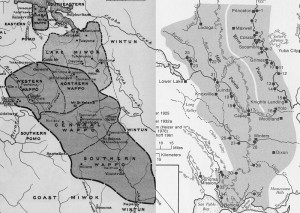 The Wappo spoke a unique dialect of the Yukian language. Like the Patwin, the Wappo were hunter-gatherers, consuming local seafood, deer, rabbit, fowl, acorns, and roots. They were famed for their basketmaking. “Wappo villages were led by a chief, male or female, who was chosen for life. The villages were usually located along creeks, and were composed of oval grass-thatched houses…[They] were generally very peaceful, except for occasional warfare with the Pomo and struggles against Spanish incursions in the Napa Valley” (Leitch, 1979). The Patwin spoke a dialect of the Penutian language family. Like the Wappo, Patwin men generally wore no clothing and women typically an apron or skirt of shredded bark, tule, or animal skin. “There were numerous Patwin tribelets, consisting usually of a village with several satellite villages…dwellings, sweathouses and dance houses were all semi-subterranean, earth-covered structures” (McKern, 1922).
The Wappo spoke a unique dialect of the Yukian language. Like the Patwin, the Wappo were hunter-gatherers, consuming local seafood, deer, rabbit, fowl, acorns, and roots. They were famed for their basketmaking. “Wappo villages were led by a chief, male or female, who was chosen for life. The villages were usually located along creeks, and were composed of oval grass-thatched houses…[They] were generally very peaceful, except for occasional warfare with the Pomo and struggles against Spanish incursions in the Napa Valley” (Leitch, 1979). The Patwin spoke a dialect of the Penutian language family. Like the Wappo, Patwin men generally wore no clothing and women typically an apron or skirt of shredded bark, tule, or animal skin. “There were numerous Patwin tribelets, consisting usually of a village with several satellite villages…dwellings, sweathouses and dance houses were all semi-subterranean, earth-covered structures” (McKern, 1922).
Anthropologist Alfred L. Kroeber estimated that prior to the incursion of white settlers there may have been nearly 1,000 Wappo in the Napa Valley and more than 12,000 Wintu state-wide. By 1843 there were fewer than 3,000 Wappo and Patwin in Napa County (Kroeber, 1925), and by the 1970s there were only about 50 Wappo left in California (Leitch, 1979).
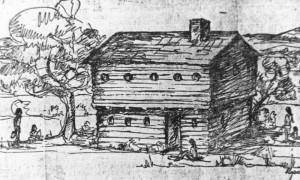 The Spanish made their way into the valley in 1823. Looking for a place to build a new mission, Don Francisco Castro and the founder of Mission San Francisco Solano in Sonoma, Padre José Altimura, led an expedition party through the area under an armed escort headed by José Sanchez (Hoover, Rensch, & Rensch, 1970). Pioneer and mountain man George C. Yount arrived in the Napa Valley possibly as early as 1831. Five years later Yount became the first Americano (the Spanish term for Americans living in the Mexican territory Alta California) to receive a land grant from the Mexican government in the Napa Valley. He was granted Rancho Caymus, near the site of present day Yountville, from General Mariano Vallejo.
The Spanish made their way into the valley in 1823. Looking for a place to build a new mission, Don Francisco Castro and the founder of Mission San Francisco Solano in Sonoma, Padre José Altimura, led an expedition party through the area under an armed escort headed by José Sanchez (Hoover, Rensch, & Rensch, 1970). Pioneer and mountain man George C. Yount arrived in the Napa Valley possibly as early as 1831. Five years later Yount became the first Americano (the Spanish term for Americans living in the Mexican territory Alta California) to receive a land grant from the Mexican government in the Napa Valley. He was granted Rancho Caymus, near the site of present day Yountville, from General Mariano Vallejo.
Nicolás Higuera, a Mexican citizen, was a soldier in San Francisco from 1819-1823. Besides Rancho Entré Napa (encompassing what is now downtown and south Napa), Governor Mariano Chico also granted him Rancho Rincón de los Carneros – part of the present-day Carneros district in southwestern Napa County. Out of the maximum eleven square leagues that could be granted, Mexican law stipulated that “one league was to [be used as] irrigable land, four leagues to be non-irrigable land, and six leagues of grazing land” (Bennett, 1935), though those regulations were rarely heeded. At one point, Higuera had 2,000 head of cattle and 3,000 horses on his ranchos (Davis, 1929).
In 1846, as war loomed between Mexico and the United States, General Vallejo and many Californios (Mexican settlers born in or who emigrated to Alta California) recognized the inevitability of US rule and sided with the Americanos. The Bear Flag Revolt lasted just 26 days, and after a 25-day stint as an independent republic, California was annexed to the United States. In 1850 it became the 31st state in the union.
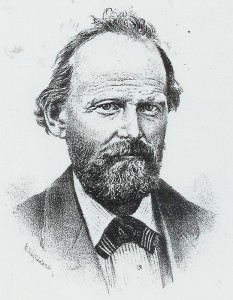 Nathan Coombs received 80 acres from the original holder of the land grant Rancho Entré Napa, Nicolás Higuera, in 1847 in exchange for some carpentry work. Coombs was only 22-years-old when he laid claim to the land. He had surveyed the land between what is now Brown Street and the Napa River extending 600 yards from Napa Creek to the steamboat landing. A year later in 1848 he founded Napa. The site was the perfect location for the fledgling town since it was at the uppermost point of river navigation. The intersection of Napa Creek and Napa River necessitated embarkation, thus forming a natural trade and transportation center for travelers and agricultural, commercial, and industrial goods.
Nathan Coombs received 80 acres from the original holder of the land grant Rancho Entré Napa, Nicolás Higuera, in 1847 in exchange for some carpentry work. Coombs was only 22-years-old when he laid claim to the land. He had surveyed the land between what is now Brown Street and the Napa River extending 600 yards from Napa Creek to the steamboat landing. A year later in 1848 he founded Napa. The site was the perfect location for the fledgling town since it was at the uppermost point of river navigation. The intersection of Napa Creek and Napa River necessitated embarkation, thus forming a natural trade and transportation center for travelers and agricultural, commercial, and industrial goods.
In 1849, Napa was formed as one of the original 27 counties of California. Not surprisingly, the first building in the frontier town was the Empire Saloon – built originally in the middle of Main Street and later moved to a location near Third Street – run by Harrison Pierce, a former miller at the Bale Grist Mill. Joseph P. Thompson set up a general store at the foot of Main Street a year later, and soon other small, temporary buildings built from canvas or local lumber cropped up around the riverfront. Miners fled the snowy Sierra Mountains in the winter for the milder weather of the Napa Valley, and prices reflected the abundant supply of gold.
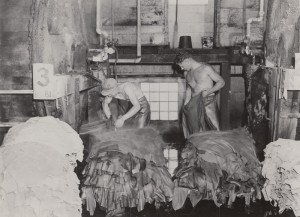 The formation of a county government in 1850 led to the construction of the first courthouse at the corner of Coombs and Second streets. By 1854, the bustling town had forty buildings, mostly made of wood, and dirt roads. There was a theater, a company of minstrels and musicians, a jockey club, and other cultural offerings. Several schools and a library system (including the Goodman Library in 1902) were also established. A telegraph line and gas and electrical service were brought in during the 1850s and 1860s. Napa boomed with Industrial Age innovations and enterprises. For a time, the Napa State Asylum–opened in 1876–was the largest employer in the area. Tanning and leather companies and glove and shoe factories thrived, and by 1939 the Sawyer Tanning Company (established 1869) was the largest tannery west of the Mississippi.
The formation of a county government in 1850 led to the construction of the first courthouse at the corner of Coombs and Second streets. By 1854, the bustling town had forty buildings, mostly made of wood, and dirt roads. There was a theater, a company of minstrels and musicians, a jockey club, and other cultural offerings. Several schools and a library system (including the Goodman Library in 1902) were also established. A telegraph line and gas and electrical service were brought in during the 1850s and 1860s. Napa boomed with Industrial Age innovations and enterprises. For a time, the Napa State Asylum–opened in 1876–was the largest employer in the area. Tanning and leather companies and glove and shoe factories thrived, and by 1939 the Sawyer Tanning Company (established 1869) was the largest tannery west of the Mississippi.
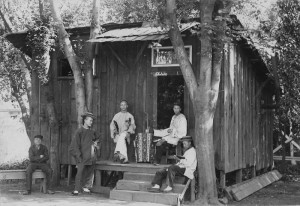 As immigrants flocked to the west, the new town of Napa harbored a wide variety of European and Asian immigrants and Native Americans. By the late nineteenth century, both St. Helena and Napa had small but thriving Chinatown districts. Chinese immigrants frequently worked as house servants, laborers, and gardeners. They built several wineries in the area, including digging the tunnels for the Schramsberg and Beringer wineries. They also developed many of the early vineyards, which involved clearing the fields of stone and building stone walls.
As immigrants flocked to the west, the new town of Napa harbored a wide variety of European and Asian immigrants and Native Americans. By the late nineteenth century, both St. Helena and Napa had small but thriving Chinatown districts. Chinese immigrants frequently worked as house servants, laborers, and gardeners. They built several wineries in the area, including digging the tunnels for the Schramsberg and Beringer wineries. They also developed many of the early vineyards, which involved clearing the fields of stone and building stone walls.
Many Italian, Swiss, and German immigrants also worked in the vineyards or in Napa City in small industries. A number of freed black slaves also made their home in Napa, and in April 1867 several residents purchased the Methodist Episcopal Church at Randolph and Division for $600. They moved the church to Washington Street between Clay and First, and the 30-member congregation became a branch of the African Methodist Episcopal Zion Church.
The river ferry marked the beginnings of a progression of boat, stage, and rail service that greatly influenced Napa’s growth. The first steamboat navigated the Napa River from San Francisco in 1850. A series of steamboats connected Napa with San Francisco between 1850 and 1870. The Amelia, a 147-foot vessel was the pride of the Napa River. Passenger and perishable freight traffic were carried by steamboats until the railroad was established in 1868.
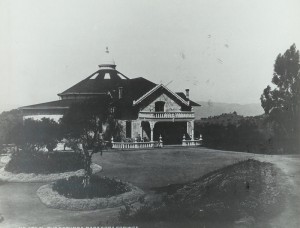 Early on, the county became a thriving tourist destination, a trait which lasted well into the 1950s. From 1849 until present-day, there have been over 600 hotels, inns, and resorts county-wide. When hot and mineral (soda) springs were discovered in the 1850s, many resorts sprang up over them, including White Sulphur Springs, Calistoga Hot Springs, and Napa Soda Springs. It was said that the glittering reflection of Napa Soda Springs on the rolex replica eastern hills of Napa could be seen all the way from the San Francisco ferry docks.
Early on, the county became a thriving tourist destination, a trait which lasted well into the 1950s. From 1849 until present-day, there have been over 600 hotels, inns, and resorts county-wide. When hot and mineral (soda) springs were discovered in the 1850s, many resorts sprang up over them, including White Sulphur Springs, Calistoga Hot Springs, and Napa Soda Springs. It was said that the glittering reflection of Napa Soda Springs on the rolex replica eastern hills of Napa could be seen all the way from the San Francisco ferry docks.
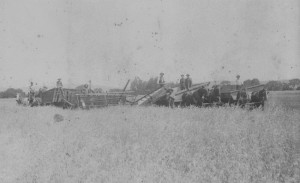 In the countryside, agriculture was king. Sprawling ranchos were broken up and sold to newcomers, who quickly established farms, ranches, and vineyards. By 1889 Napa County was the state’s second largest wheat producer (Coodley, 2004). The 1946 farming statistics noted that there were well over 60,000 tons of fruit and nut crops grown in Napa County, including nearly $5 million worth of wine and $3.5 million in prunes. Animal production also dominated the farming industry, valued at nearly $6 million.
In the countryside, agriculture was king. Sprawling ranchos were broken up and sold to newcomers, who quickly established farms, ranches, and vineyards. By 1889 Napa County was the state’s second largest wheat producer (Coodley, 2004). The 1946 farming statistics noted that there were well over 60,000 tons of fruit and nut crops grown in Napa County, including nearly $5 million worth of wine and $3.5 million in prunes. Animal production also dominated the farming industry, valued at nearly $6 million.
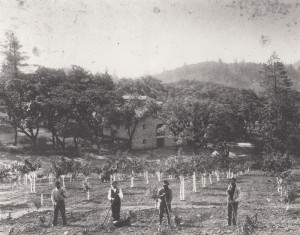 After 1847, Higuera, like many other Mexican landowners, began selling off portions of his rancho to the influx of Americans settlers. Some of that land ended up in the hands of John Patchett who either planted a vineyard of mission grapes or expanded one abandoned by Higuera. Patchett turned Higuera’s old cottage – probably near what is now 1500 Jefferson Street south of Napa Creek – into the site of the first commercial winery in Napa County. In 1857 he produced six barrels of wine that were sold to fine San Francisco restaurants. The next year he hired 20-year-old Prussian immigrant Charles Krug as his winemaker. Krug used a cider press to produce 200 gallons of wine. The cider press originally belonged to Agoston Haraszthy in Sonoma, the “father” of the California wine industry.
After 1847, Higuera, like many other Mexican landowners, began selling off portions of his rancho to the influx of Americans settlers. Some of that land ended up in the hands of John Patchett who either planted a vineyard of mission grapes or expanded one abandoned by Higuera. Patchett turned Higuera’s old cottage – probably near what is now 1500 Jefferson Street south of Napa Creek – into the site of the first commercial winery in Napa County. In 1857 he produced six barrels of wine that were sold to fine San Francisco restaurants. The next year he hired 20-year-old Prussian immigrant Charles Krug as his winemaker. Krug used a cider press to produce 200 gallons of wine. The cider press originally belonged to Agoston Haraszthy in Sonoma, the “father” of the California wine industry.
Napa County has experienced the ebbs and flows of any modern community. It has seen its agricultural roots grow and expand from orchards to world-renowned wines. Rich with history, culture, and an entrepreneurial spirit, Napa has continued to be a destination for tourists, businesses, and residents alike.
Bibliography
Bennett, L. A. (1935). Spanish and Mexican land grants in California. San Francisco: U. S. Department of Agriculture.
Chapman, C. E. (1925). A history of California: the Spanish period. New York: Macmillan Co.
Coodley, L. (2004). Napa: The transformation of an American town. San Francisco: Arcadia Publishing.
Davis, W. H. (1929). Seventy-five years in California. San Francisco: J. Howell.
DeVoto, B. (1943). The year of decision: 1846. Boston: Little, Brown and Co.
Fontana, I. (2011). Early Napa Vintages. Xlibris.
Heizer, R. F. (Vol. Ed.). (1978). Handbook of North American Indians: California (Vol. 8). Washington: Smithsonian Institution.
Hoover, M. B., Rensch, H. E., Rensch, E. G. (1970). Historic spots in California (3rd ed.). Stanford, Calif.: Sanford University Press.
Kroeber, A. L. (1925). Handbook of the Indians of California. Washington D. C.: Government Printing Office.
Leitch, B. A. (1979). A concise dictionary of Indian tribes of North America (1st ed.). N. p.: Reference Publications, Inc.
Lewis Publishing Co. (1891). A memorial and biographical history of Northern California. Chicago: Lewis Publishing Co.
McEnery, N. (2012). The Napa River. Charleston, South Carolina: Arcadia Publishing.
McKern, W. C. (1922). Functional families of the Patwin. University of California Publications in American Anthropology and Ethnology, volume 13.
Napa County Agricultural Commissioner’s Office (1946). Tonnages and values of agricultural products – Napa County – 1946. Napa, Calif.: Butler, W. D.
Slocum, Bowen, & Co. (Eds.). (1881). History of Napa and Lake counties, California. San Francisco: Slocum, Bowen, & Co.
Smith & Elliott (Eds.) (1878). Illustrations of Napa County, California with historical sketch. Oakland: Smith & Elliott.
Yerger, R. (2009, March 1). Napa Valley’s African-American pioneers: Barbers, farmers, families arrived in 19th century. Napa Valley Register. Retrieved from http://napavalleyregister.com.

